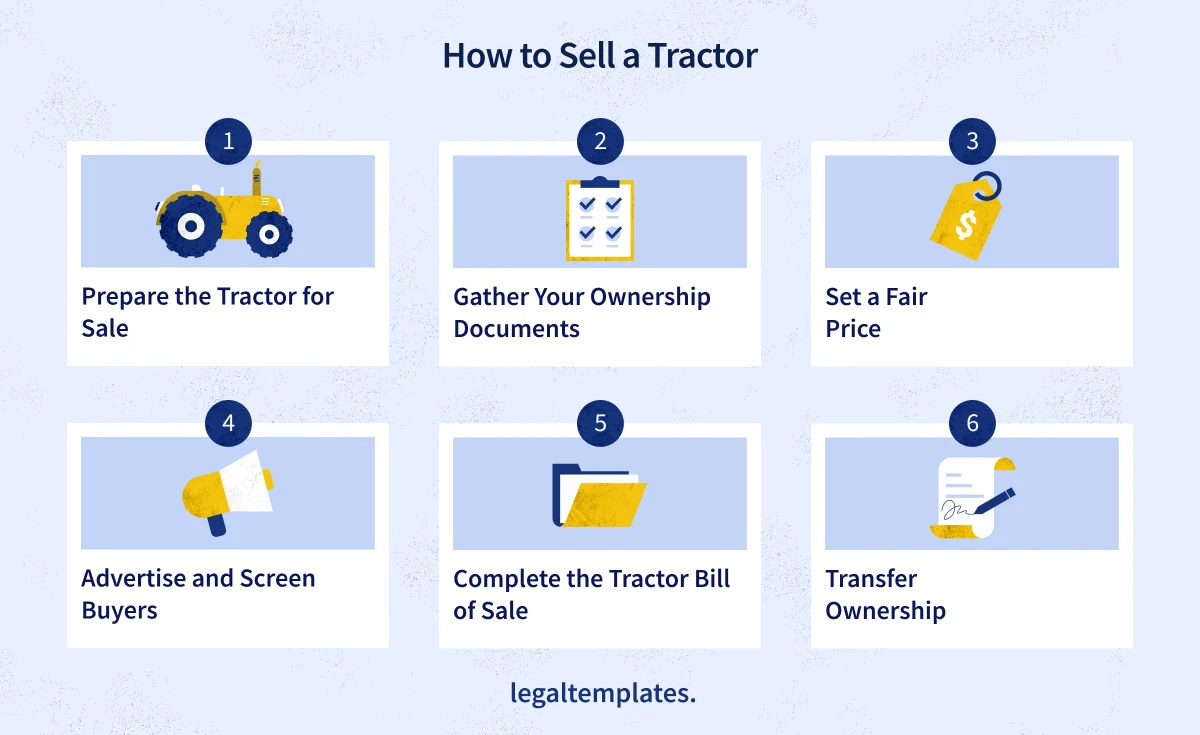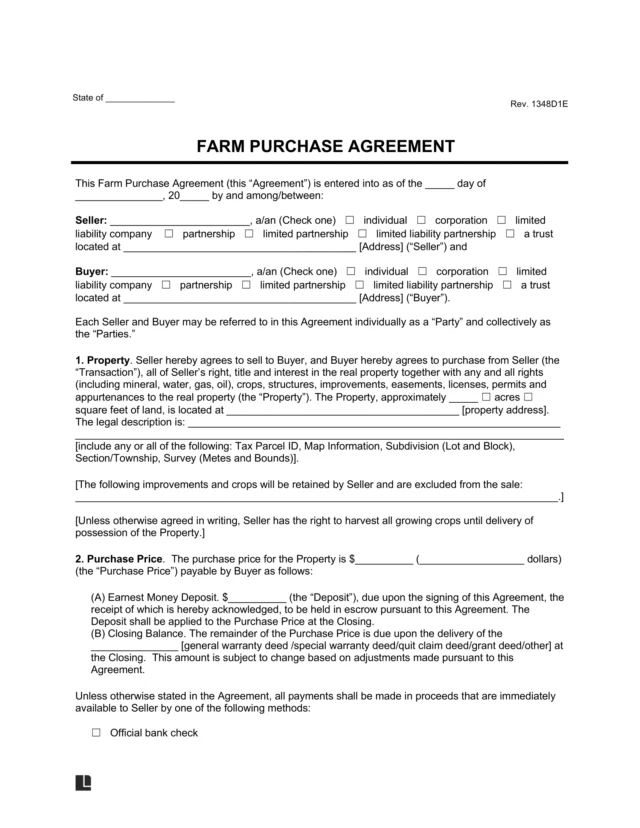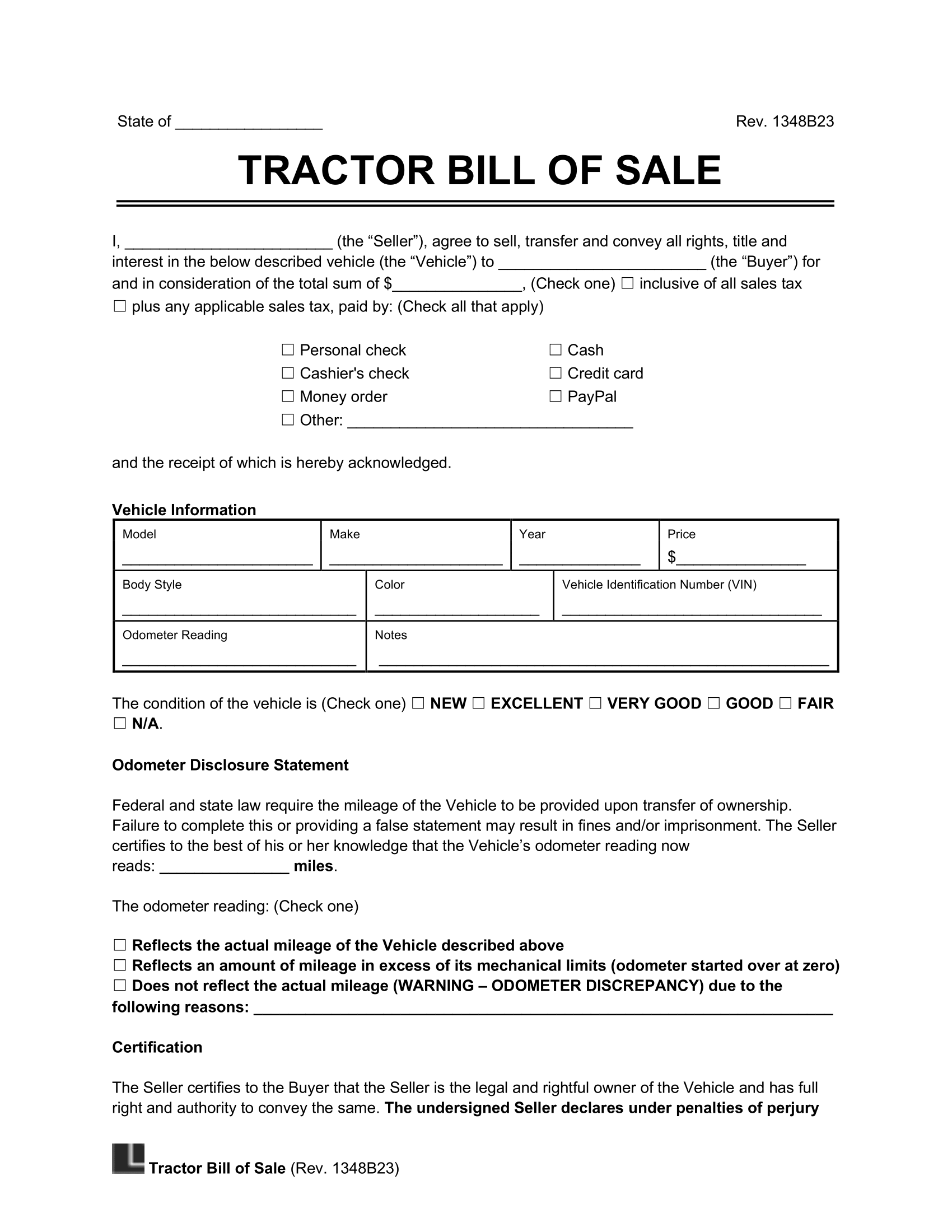What Is a Tractor Bill of Sale?
A tractor bill of sale is a legal document that confirms the transfer of a tractor from one person to another. It creates a clear record of the sale by listing:
- The buyer and the seller
- A description of the tractor being sold
- The sale price and date of the transaction
Tractors are often considered high-value goods, which means a written record of sale can help meet state contract laws based on Uniform Commercial Code Section 2-201, which generally requires sales of items worth more than $500 to be in writing to be legally enforceable. Legal Templates offers a free tractor bill of sale form that you can customize and download in PDF or Word format to create a clear record of your tractor sale.
When Do You Need a Bill of Sale for a Tractor?
You may need to use a tractor bill of sale anytime the ownership of a tractor changes hands in a private sale. This form is commonly used whenever:
- You are selling a tractor in a private sale, such as between individuals or a small business.
- You need proof of purchase to obtain or transfer a title, register the tractor for road use, or update the name on an insurance policy, depending on your state’s rules.
- You want to keep a record for tax or business purposes, such as reporting the sale or tracking depreciation.
Use this bill of sale when you’re selling the tractor itself. If you’re selling only attachments or non-motorized farm equipment, such as front loaders, backhoes, mower decks, you may need an equipment bill of sale instead.
What to Include in a Tractor Bill of Sale
A bill of sale for a tractor should clearly outline the details of the transaction, allowing both parties to maintain an accurate record of the sale. While requirements may vary from one state to another, a well-written tractor bill of sale form should include the following information:
1. Buyer and Seller Information
Start by listing the basic contact details for both the buyer and the seller. List the full legal names and mailing addresses of both parties. This information helps identify who transferred the ownership and to whom it is being transferred.
2. Tractor Identification
Write down enough details about your tractor in your bill of sale to show which tractor the buyer is purchasing, so there isn’t any confusion. Include the following details:
- Make, model, and year
- Serial number or VIN, if the tractor has one
- Engine or hour-meter reading
- Fuel type, such as diesel, gas, or electric
- Drive type, such as 2WD or 4WD
- Overall condition, such as new, used, or needs repairs
- Any major defects the buyer should know about
Some states may require sellers to disclose mileage or hours when transferring ownership for a tractor. You can use a free odometer disclosure statement to meet that requirement.
3. Sale Terms
Add key agreed-upon terms of the sale, including things like purchase price and payment method. Moreover, you can specify whether the tractor is sold “as-is” or if it has any implements or attachments permanently attached to it at the time of sale, such as a mower deck. Be sure to mention any existing liens and specify how they will be handled before ownership transfer. Clear sale terms can help both parties understand what is included and what is not.
4. Parties’ Signatures
Both parties must sign and date the tractor bill of sale form to confirm the transfer of ownership. Some states may also require a notarized bill of sale when transferring a titled tractor or registering a tractor for road use. In other states, notarization is optional but can help prevent disputes.
Sample Tractor Bill of Sale Form
Take a look at a sample tractor bill of sale template below to see what information to include. Once you’re ready, use our step-by-step questionnaire to customize your own bill of sale for a tractor and download it as a PDF or Word file. You can also get a free printable tractor bill of sale for your records.
How to Sell a Tractor

Selling a tractor can be pretty straightforward as long as you prepare ahead of time and document the sale properly. Follow the steps below to learn how to prepare your tractor, find a buyer, and transfer ownership.
Step 1 – Prepare the Tractor for Sale
Before listing your tractor, take the time to prepare your vehicle. Cleaning the tractor and addressing any minor repairs can make a strong first impression and help attract serious buyers. A well-maintained tractor is often easier to sell.
Step 2 – Gather Your Ownership Documents
Collect all the paperwork related to your tractor. This may include the title (if your state issues one), along with any prior bill of sale or lien release. Keeping these documents readily available can help the sale move forward smoothly once you find a buyer.
Step 3 – Set a Fair Price
Conducting market research will help you determine a reasonable asking price. Look at similar tractors for sale, review dealer quotes if available, and consider the tractor’s condition and hours of use. Pricing the tractor reasonably can help it sell faster.
Step 4 – Advertise and Screen Buyers
Once you’re ready to sell, start advertising your tractor. Take clear photos and write an honest description that accurately matches the item’s condition. Listing the tractor online on platforms like Machinery Pete and TractorHouse or locally can help you reach interested buyers. Be prepared to answer any questions they may have and confirm that buyers are serious before moving forward.
Step 5 – Complete the Tractor Bill of Sale
After you and the buyer agree on the price and terms, complete the tractor bill of sale. To speed up the process, you can use Legal Templates’s free tractor bill of sale template that includes all the important information. Our guided form helps you quickly fill out your information and download the file in PDF or Word format.
Step 6 – Transfer Ownership
Once the payment is complete, finalize the transfer. If your state requires it, sign over the title and give the buyer a copy of the tractor bill of sale form. You may also need to complete state-specific registration steps if the tractor will be used on public roads.






